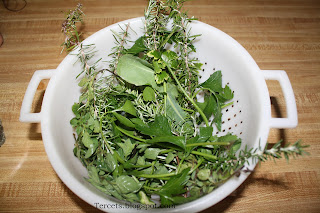As I look at the stats for this blog, I’ve noticed that readers seem most interested in the entries labeled “healthy living” and “food,” so I’m going to write a couple in a row for you. I appreciate your comments, and I hope you’ll leave more, especially if you like something, or have suggestions.
First course: Chopped rosemary, oregano, and parsley mixed on a plate with extra virgin olive oil. A great dip for bread! My six year old said this is her favorite recipe. Probably because once I’ve cut the herbs, she can make it herself!
Second course: Basil leaves, fresh chopped tomatoes, and chunks of fresh cheese. Mozzarella is great, but we used Queso Fresco, a soft white Mexican cheese that is less costly at our local supermarket. Wrap the cheese and tomato pieces in basil leaves to eat them, like taquitos (small tacos), or “a larvae inside a leaf”, according to my six year old.
Third course: Small farfalle (bowties) pasta dressed with extra virgin olive oil or garlic flavored olive oil, chopped basil, oregano, and parsley. Use as many or few herbs as you like. If have extra tomatoes, add them too. If you have time, make a pesto from basil, parsley, or even cilantro. (Leftover pesto? Freeze it for later! Got some in the freezer? Use it for this!) Always serve pesto at room temperature to preserve the raw enzymes in the herbs, garlic, and olive oil.
Enzymes from raw plant foods aid in the digestion of cooked foods, thus preserving the body’s supply of enzymes for other uses, such as immune system fights against cancer causing agents and cancer cells themselves. More about how to incorporate raw foods into meals (not just as salads) in future posts (Read part 1 here and part 2 here).
Raw parsley contains high levels of the anti-oxidant glutathione, an important fighter against cancer-causing agents (free radicals) that also protects the lenses of the eyes from ultraviolet light and that neutralizes rancid oxidized fats (from cooking foods at high temperatures) that contribute to clogged arteries. Glutathione also boosts the immune system, detoxes pollutants, reduces inflammation, and repairs damaged DNA. Our bodies can make glutathione, but our ability to do so diminishes around age 40, so it is an important part of a healthy diet, especially as we age. Another great way to use raw parsley: make tabouli.
Broccoli and spinach are also good sources of glutathione. Much of it is lost during cooking, so it’s important to eat these foods both raw and cooked. For example, cooking makes the calcium and beta-carotene in spinach more absorbable even though glutathione is depleted.
See my post Growing Your Own for information on the medicinal benefits of raw oregano and rosemary.
My next post will be about the recently announced replacement for the food pyramid: Myplate.gov.
See my post Growing Your Own for information on the medicinal benefits of raw oregano and rosemary.
My next post will be about the recently announced replacement for the food pyramid: Myplate.gov.
Nourishing Traditions: The Cookbook that Challenges Politically Correct Nutrition and the Diet Dictocrats
SuperFoods Rx: Fourteen Foods That Will Change Your Life
Ann Kroeker hosts a weekly Food on Fridays Linkup, so I have connected there, where you will find many links somehow (either
casually or directly) related to food and recipes. Go see her GFCF veggie pizza recipe.
I have also added this post to this
week’s Ultimate Recipe Swap hosted by Jessica at life as mom. This week’s theme is Chef’s Choice; she is
sharing a pasta dish with ingredients made from leftovers.




I'm enjoying reading all of your posts! Are herbs something that can be grown year round? I really want to start a raised garden next spring, but maybe I can start some potted herbs now? We like bread dipped in olive oil, but I never thought of adding the fresh herbs to the oil. Thanks for sharing!
ReplyDeleteThanks, Jen. Here in Houston, we can grow some herbs year round. My oregano and rosemary survive every winter, and my basil, parsley, and cilantro often spontaneously sprout from seed in the spring. All of these can easily grow in pots, and they should do well, especially if you start them now with seedlings or more mature growth. You may have to move them to bigger pots later on to maintain growth. I can even give you some oregano to start. Good luck!
ReplyDelete